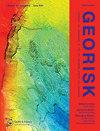隧道掘进机(TBM)施工数据的跨项目利用——以中国银松引水工程大数据为例
IF 4.8
3区 工程技术
Q1 ENGINEERING, GEOLOGICAL
Georisk-Assessment and Management of Risk for Engineered Systems and Geohazards
Pub Date : 2023-01-02
DOI:10.1080/17499518.2023.2184834
引用次数: 3
摘要
由于隧道掘进机设备和隧道地质信息的变化,导致隧道掘进机实时掘进数据存在较大差异。这种变化使得在新项目中应用由历史工程数据训练的机器学习模型变得困难。为了克服这一挑战,从力学分析的角度提出了一种新的数据转换方法,用于规范TBM掘进数据,如刀盘扭矩和刀盘推力,这有助于在同一框架下统一来自不同项目的数据。此外,通过类比分析和机器学习应用验证了该方法的有效性。通过这些转换关系的应用,在已完成的具有大数据(12,501个钻孔周期)的银松项目上训练的机器学习模型应用于中国正在进行的具有有限数据(777个钻孔周期)的银朝调水项目,并给出了每个性能参数的可靠预测(刀盘推力R2为0.81,刀盘扭矩R2为0.70)。该方法提高了TBM智能在不同地质条件下跨工程物探中的应用价值。本文章由计算机程序翻译,如有差异,请以英文原文为准。
Cross-project utilisation of tunnel boring machine (TBM) construction data: a case study using big data from Yin-Song diversion project in China
ABSTRACT The variation in Tunnelling boring machine (TBM) equipment and geological information of tunnels result in substantial differences in real-time TBM tunnelling data. This variation makes it difficult to apply machine learning models trained by historical engineering data on new projects. To overcome this challenge, a novel data conversion approach from a mechanical analysis perspective has been proposed to normalise TBM tunnelling data, such as cutterhead torque and cutterhead thrust, which help to unify data from different projects under the same framework. Furthermore, the effectiveness of this approach has been verified through analogy analysis and machine learning applications. With the application of these conversion relationships, the machine learning model trained on a completed Yin-Song project with big data (12,501 boring cycles) is applied to the on-going Yin-Chao Water Diversion Project in China with limited data (777 boring cycles) and gives reliable predictions for each performance parameter (with R2 for the cutterhead thrust of 0.81 and R2 for the cutterhead torque of 0.70). This approach enhances the usefulness of TBM intelligence for cross-engineering geophysical prospecting in different geological conditions.
求助全文
通过发布文献求助,成功后即可免费获取论文全文。
去求助
来源期刊
CiteScore
8.70
自引率
10.40%
发文量
31
期刊介绍:
Georisk covers many diversified but interlinked areas of active research and practice, such as geohazards (earthquakes, landslides, avalanches, rockfalls, tsunamis, etc.), safety of engineered systems (dams, buildings, offshore structures, lifelines, etc.), environmental risk, seismic risk, reliability-based design and code calibration, geostatistics, decision analyses, structural reliability, maintenance and life cycle performance, risk and vulnerability, hazard mapping, loss assessment (economic, social, environmental, etc.), GIS databases, remote sensing, and many other related disciplines. The underlying theme is that uncertainties associated with geomaterials (soils, rocks), geologic processes, and possible subsequent treatments, are usually large and complex and these uncertainties play an indispensable role in the risk assessment and management of engineered and natural systems. Significant theoretical and practical challenges remain on quantifying these uncertainties and developing defensible risk management methodologies that are acceptable to decision makers and stakeholders. Many opportunities to leverage on the rapid advancement in Bayesian analysis, machine learning, artificial intelligence, and other data-driven methods also exist, which can greatly enhance our decision-making abilities. The basic goal of this international peer-reviewed journal is to provide a multi-disciplinary scientific forum for cross fertilization of ideas between interested parties working on various aspects of georisk to advance the state-of-the-art and the state-of-the-practice.

 求助内容:
求助内容: 应助结果提醒方式:
应助结果提醒方式:


